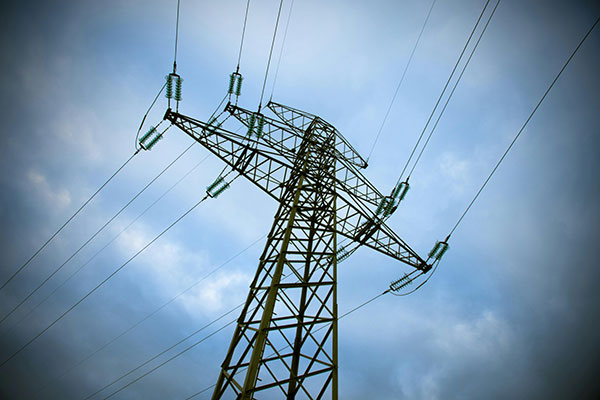As grid investments pour in and urgency ramps up due to more extreme weather events, a new market for grid resilience technologies emerges.
by Mishal Thadani
Next time you ride the Metro in Washington, D.C., look around and you’ll likely see an advertisement for Pepco, the local electric utility, and their Power Line Undergrounding Program to increase the reliability and resilience of the local grid. Around the country, billboards and digital advertisements champion infrastructure projects that prevent power outages amid growing extreme weather threats, following a wave of federal and state policies supporting these efforts. Beneath the surface, a vibrant market for grid resilience projects, programs, and technologies is rapidly growing, placing climate adaptation at the center of the electric utility industry.
As climate hazards of all varieties intensify, the power grid is seeing a greater number of outages that are also becoming more costly for utilities to recover from. So much that in 2023, U.S. electric utilities spent a record $171B on their capital expenditures, with the largest spending category for transmission and distribution utilities being directed to hardening the grid against growing extreme weather threats.

In California, as if wildfires weren’t enough of a concern, the state recently experienced an atmospheric river –– a weather phenomenon which is becoming more frequent –– that caused prolonged precipitation, strong winds, mud slides, and ultimately power outages for over 1 million people in the Bay Area and over 500,000 in Los Angeles. In the winter, the central U.S. is now consistently facing freezing temperatures, heavy snow and winds as polar vortexes are anticipated to become an annual threat. Even for brand new infrastructure, electric grid component standards were not designed against future climate risk profiles that are becoming the reality of today.
Utilities need to operate the grid reliably, modernize for the future, and do it all while keeping bills affordable for customers. Infrastructure costs money, a lot of money, yet consumers have demonstrated that investments to increase reliability and resilience, especially against extreme weather events, are a priority. As climate concerns increase around the country, utilities, their regulators, and the federal government are creating an ecosystem for resilience investments that represents one of the fastest-growing markets related to the power grid.
Defying their reputation, utilities are moving swiftly to deploy solutions that will mitigate future extreme weather risks. Here’s a snapshot of what this market looks like.
Just like in Washington, D.C., many places around the country are seeing a movement to place overhead infrastructure underground. This is particularly notable in California where PG&E is trying to bury 10,000 miles of overhead infrastructure to mitigate wildfire risk, and in Florida, where electric utilities aim to minimize power outages and emergency response efforts due to more frequent hurricanes. At the same time, utilities are expanding their transmission capacity to accommodate more renewable energy and ensure that the grid can ride through heat waves and cold snaps. These transmission lines are often coupled with dynamic line rating capabilities and other devices that control how much power is allowed to flow through the cables.
To enhance resources for communities during extreme weather events, electric utilities are partnering with community organizations to develop Community Resilience Hubs, which are facilities that can disconnect from the centralized power grid and supply their own energy through a microgrid. In the south side of Chicago, Commonwealth Edison has developed the Bronzeville Community Microgrid to make the neighborhood self-sufficient with its power generation instead of relying on the complex (and vulnerable) tapestry of transmission and distribution lines. Other utilities such as Xcel, WEC, and Los Angeles Department of Water and Power are also pursuing community microgrids.
Move over carbon mitigation; climate adaptation technologies are reaching scale. Utilities are buying new hardware devices such as reclosers, which can isolate a power outage and automatically restore power to the majority of customers. Many utilities in the West are deploying AI-enabled cameras in the field for early wildfire detection and situational awareness. Utilities are also deploying sensors on the grid for real-time visibility into power flow irregularities that alert them to mobilize field crews.
On the software side, the availability of data sets and AI technology has reached a point of enterprise scale, providing enormous value to utility planning and operations. For real-time operations, utilities are using digital tools for satellite-based vegetation management and distribution grid orchestration to tap into distributed resources when the grid is at its peak. Similarly, available data from global climate models can be used to understand long-term extreme weather risk to utility assets and optimize investment planning for many of the interventions above.
Extreme temperature events combined with growing electrification will likely cause capacity constraints and congestion much faster than we anticipate, and without intervention could lead to controlled, sectionalized power outages by utilities. In a true matter of life or death, power outages during prolonged extreme heat days could contribute to a seven-fold increase in heat-related mortality during those events.
While utility-implemented energy efficiency has long been championed as an effective tool to mitigate such effects, newer technologies such as smart thermostats, behind-the-meter battery storage, and smart water heaters have the ability to curb peak load consumption by up to 30%. The enabling programs –– demand response, time-of-use rates, and managed electric vehicle charging –– are catalyzing a wave of software technologies to make this possible.
At some point in the near future the question will no longer be if utilities can adequately guarantee resilience for their customers, but how they’ll be doing it. What mix of solutions will they use? To what scale? In which locations? New technologies and programs represent a growing toolkit for combatting extreme weather events on the grid, and we should expect this market to grow with the evolving risk profiles in various geographies around the U.S.

About the Author
Mishal Thadani is the CEO and co-founder of Rhizome, a climate resilience software company that helps utilities, governments and corporations identify vulnerabilities from extreme weather threats and optimize asset investments. Mish has an extensive background in clean energy and market development and for 10 years, helped cleantech companies navigate complex regulatory frameworks and market dynamics to advance technology adoption for a more sustainable and resilient future. Prior to Rhizome, Mish was the VP of Strategy and Policy at Urbint where he led go-to-market and regulatory strategies from Series A to Series C and became recognized as an industry leader in infrastructure resilience.
In this episode, I sat down with Beejan Giga, Director | Partner and Caleb Emerson, Senior Results Manager at Carpedia International. We discussed the insights behind their recent Industry Today article, “Thinking Three Moves Ahead” and together we explored how manufacturers can plan more strategically, align with their suppliers, and build the operational discipline needed to support intentional, sustainable growth. It was a conversation packed with practical perspectives on navigating a fast-changing industry landscape.